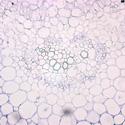Group on Plant Pathology
Lines of research

• Genetic resistance to control plant pathogenic viruses. Plant viruses are very important agricultural pathogens, and are responsible for a significant part of the commercially relevant plant diseases. There are very few efficient control measures for viral diseases, but the use of genetic resistance appears to be the most promising strategy, often conferring effective protection without additional costs or labour during the growing season, and without damaging the environment. We work in three aspects that require intense investigation in this line: (a) Identification of new sources of resistance, including germplasm screenings and dissection of resistance phenotypes. (b) Analysis of molecular mechanisms controlling resistance. (c) Analysis of resistance durability, examining factors that influence durability and how this can be predicted.
commercially relevant plant diseases. There are very few efficient control measures for viral diseases, but the use of genetic resistance appears to be the most promising strategy, often conferring effective protection without additional costs or labour during the growing season, and without damaging the environment. We work in three aspects that require intense investigation in this line: (a) Identification of new sources of resistance, including germplasm screenings and dissection of resistance phenotypes. (b) Analysis of molecular mechanisms controlling resistance. (c) Analysis of resistance durability, examining factors that influence durability and how this can be predicted.
• Cap-independent translation of viral and host mRNAs. Translation of messenger RNAs (mRNAs) and, in particular, translation initiation, is a complex process often targeted  by viruses to preferentially translate viral mRNAs. Many plant viruses (in particular those belonging to the family Tombusviridae) contain specialized structural elements at their 3´-UTRs that function as cap-independent translation enhancer elements (3´-CITEs). We have characterized the amazing diversity of Melon necrotic spot virus (MNSV) 3´-CITEs, showing that they consist of modular elements that can be transferred among viral species through RNA recombination, interacting differentially with host elements to confer host range specificity. Further characterization of 3´-CITEs from both structural and functional points of view is the research goal in this line.
by viruses to preferentially translate viral mRNAs. Many plant viruses (in particular those belonging to the family Tombusviridae) contain specialized structural elements at their 3´-UTRs that function as cap-independent translation enhancer elements (3´-CITEs). We have characterized the amazing diversity of Melon necrotic spot virus (MNSV) 3´-CITEs, showing that they consist of modular elements that can be transferred among viral species through RNA recombination, interacting differentially with host elements to confer host range specificity. Further characterization of 3´-CITEs from both structural and functional points of view is the research goal in this line.
• Viral factories: description, composition and function. Plant cells infected by RNA viruses often show extensive membrane and organelle rearrangements, including the formation of spherules, vesicles,  and/or multivesicular bodies. These virus-induced organelles house the viral RNA replication complex and are known as virus factories or viroplasms. In addition to viral RNA replication, the factories may be involved in other processes such as viral RNA translation and cell-to-cell virus transport. We are working on the characterisation of viral factories associated with MNSV and PepMV. We are using both transmission electron and laser confocal microscopy to identify and characterise MNSV and PepMV induced cellular rearrangements, and to localise virus and host factors inside them.
and/or multivesicular bodies. These virus-induced organelles house the viral RNA replication complex and are known as virus factories or viroplasms. In addition to viral RNA replication, the factories may be involved in other processes such as viral RNA translation and cell-to-cell virus transport. We are working on the characterisation of viral factories associated with MNSV and PepMV. We are using both transmission electron and laser confocal microscopy to identify and characterise MNSV and PepMV induced cellular rearrangements, and to localise virus and host factors inside them.
• Ecology and evolutionary dynamics of emerging plant viruses. Emerging infectious diseases (EIDs) are historically one of the most important problems in agriculture. Viruses cause the majority of EIDs in plants. Recent examples of EIDs in the Mediterranean Basin include those induced by PepMV and Tomato torrado virus in tomato, and Cucurbit aphid-borne yellows virus (CABYV) and Moroccan watermelon mosaic virus (MWMV) in cucurbits. We are studying the ecology, genetic diversity and evolutionary dynamics of these viruses to understand the factors and processes governing the emergence of viral diseases.
cause the majority of EIDs in plants. Recent examples of EIDs in the Mediterranean Basin include those induced by PepMV and Tomato torrado virus in tomato, and Cucurbit aphid-borne yellows virus (CABYV) and Moroccan watermelon mosaic virus (MWMV) in cucurbits. We are studying the ecology, genetic diversity and evolutionary dynamics of these viruses to understand the factors and processes governing the emergence of viral diseases.






